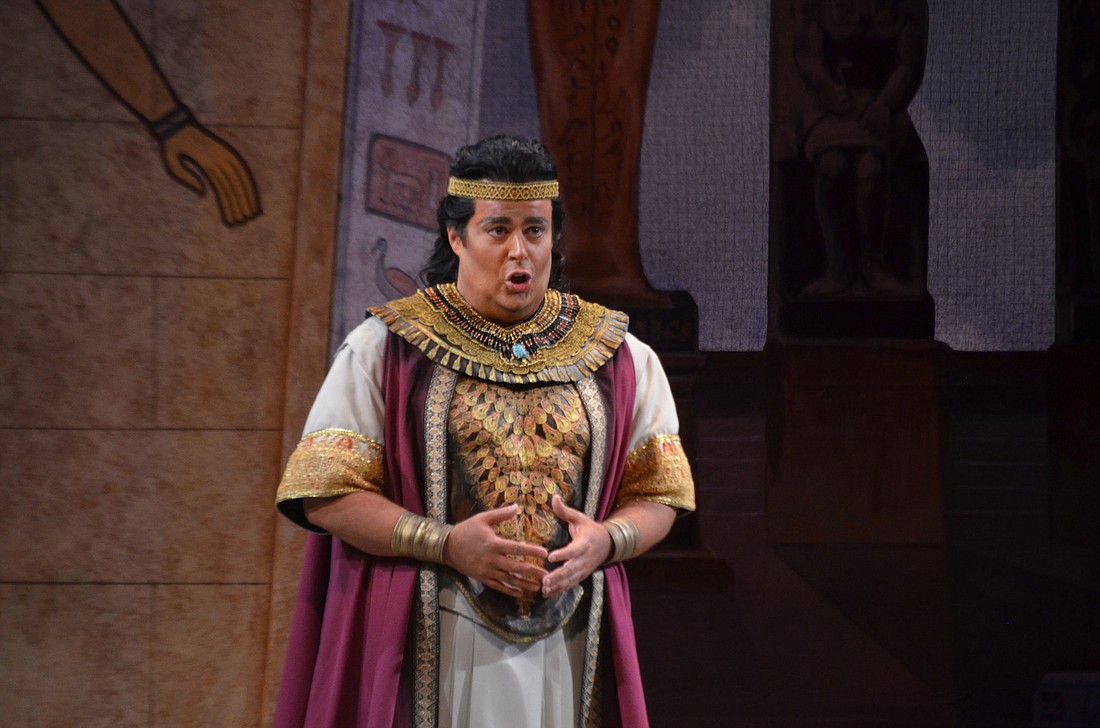- November 23, 2024
-
-
Loading

Loading

Electricity was in the air as the Sarasota Opera opened the final season of its 28 year Verdi cycle. It could be felt on the operatic side of Pineapple Avenue, which had just been renamed “Verdi Place,” and it was positively palpable inside the house where a sold-out crowd, glittering and glowing with energy, was awaiting the Verdian masterwork that had so far eluded the Sarasota Opera’s stage.
It’s not that “Aida” has been too much for the world-class Sarasota Opera to take on before this. For the most part, “Aida” is a chamber opera dealing with only five major roles and Verdi’s masterful setting of still another father-daughter relationship. The Maestro had many such connections in his operas: Rigoletto and Gilda, Germont and his daughter (implied) in Traviata, and similar bonds in “Luisa Miller,” “Simon Boccanegra,” and La Forza del Destino,” to name just a few. But, with “Aida,” there are two of these bonds: The King of Egypt and his daughter, Amneris; and Amonasro, King of Ethiopia, and his daughter, Aida. Those four characters make up the meat of this opera, along with the object of both daughters’ affection, Radames, the hero-turned-traitor.
We lied. There may be only five lead characters and the opera may be about their loves and passions (for country, family and each other), but there’s also one scene - - the famous Triumphal Scene in the second half of Act II - - that has what seems like hoards of people processing across the stage. Animals aren’t needed (or called for except by tradition), but there are teeming crowds, guards, soldiers, dancers, trumpeters and entertainers traversing the stage and, even with the multi-million dollar renovation of the Opera House that enlarged the pit and did beautiful things to the house, itself, the stage has had to remain small for a company of this reputation.
That’s where the stagecraft of Director Stephanie Sundine, Scenic Director David P. Gordon and Lighting Designer Ken Yunker came in. Parading more people than have ever appeared in the company’s history, we were convinced the entire Egyptian population was lined up to the Tamiami Trail and marching across the stage, while four mighty trumpeters (playing long Herald Trumpets) were proclaiming their arrival with Verdi’s brilliant Triumphal March.
The superb chorus was a character in itself, giving us a feeling of being surrounded by sound even though they were all singing from the stage. Chorus Master Roger Bingaman deserves special praise for the glorious blend and fluidity of the ensemble which was made up of Sarasota Opera’s Studio Artists and Apprentices, including Mary-Hollis Hundley, who sang the off-stage voice of the Priestess. And choreographer Miro Magloire made magic with dancers who seemed to have all the space in the world in just a few feet center stage.
But that was only one exquisite scene of many. There was a magnificent full moon shining over the pyramids and the Nile in Act III. There were temples and halls reminiscent of the magnificent Egyptian wing of the Metropolitan Museum in New York. There were luminescent gowns (Howard Tsvi Kaplan) for the women and golden threads glimmering in Amneris’ hair.
And there was the orchestra, led with brilliance and authority by Artistic Director Victor DeRenzi, that was as magnificent as all the pomp and ceremony up on the stage. The winds were particularly noteworthy, with some spectacular playing by the oboist and English horn in some of the chamber-like arias.
Speaking of arias, although “Aida” is through-composed, it is filled with some of Verdi’s most tuneful, impassioned pieces we know. And the five leads were truly great singers. Michelle Johnson is reminiscent of a young Leontyne Price with a large, sumptuous voice that has both sweetness and bite. I’d have liked a bit more “float” in her aria, “O patria mia,” on her high C, and her final A, which is marked “smorzando” (dying away). But it was still magnificent singing throughout.
Leann Sandel-Pantaleo is a truly great Amneris with a luxurious, huge sound throughout her range that, even in her jealous tirades, never loses its luster and beauty. Having sung at the Met and La Scala, she is a singer to watch although, judging from this performance, she’s already at the top of the list of greats for this role.
Jonathan Burton, who made a stentorian Calaf in Sarasota Opera’s “Turandot” a few years ago, was in excellent voice as Radames and his opening “Celeste Aida” was formidable as was his final duet with Aida in the tomb scene.
Marco Nistico was an admirable Amonasro, and, although he had a slightly shaky start, his vocalism smoothed out and his acting riveted attention on him even when he was hiding off stage getting the inside information on the Egyptian’s war plans. Jeffrey Beruan made an excellent King; Young Bok Kim, with his deep chested bass, was an impressive Ramfis; and Studio Artist, Matthew Vickers made an admirable impression in his brief role as a Messenger.
“Aida” is one of the first operas most of us see. Whether you’ve seen it once or a hundred times, this is a production worth attending. In every way, it’s worthy of the world-wide attention the Verdi Cycle is getting for the Sarasota Opera.